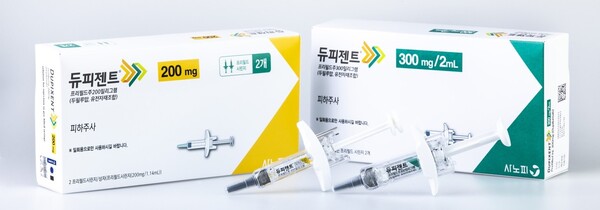Sanofi has requested the insurance coverage of Dupixent (dupilumab) as a treatment for atopic dermatitis and asthma for children and adolescents but achieved only half-success.
In the committee meeting to evaluate insurance coverage for drugs held by the Health Insurance Review and Assessment Service (HIRA) on Thursday, Dupixent’s insurance benefit was recognized as appropriate as a treatment for atopic dermatitis for children and adolescents.

In 2018, the drug won approval for its indication to treat atopic dermatitis in adults for the first time in Korea in 2018. It expanded its indication to adolescents in April 2020 and children in March 2021.
The Ministry of Food and Drug Safety has approved the use of Dupixent in adults (18 and older), adolescents (12-17 years old), and children (six months to 11 years) to treat moderate and severe atopic dermatitis that topical remedies cannot properly control or such treatments are not recommended.
Children and adolescents with severe atopic dermatitis have very limited treatment options, and Dupixent is the only biochemical medicine approved for these patients.
Adult patients have sharply reduced their financial burden as the drug received health insurance benefits from January 2020, but adolescents and children have not enjoyed similar benefits, causing them and their parents to submit numerous civil petitions,
Without insurance coverage, the cost of Dupixent exceeds 20 million won ($16,000) a year, posing heavy financial burdens on these younger patients and their patients, forcing them to give up or discontinue treatment halfway.
If drug price negotiation proceeds without a hitch, children and adolescent patients will likely benefit from reduced burdens during the first half-year.
On the other hand, Sanofi reportedly requested insurance coverage for the same drug’s indication for asthma.
However, the review panel decided to “hold decisions on reimbursement standards,” and the company received only a half-fulfilled report card.
Dupixent is an alternative, allowing severe asthma patients to reduce or discontinue oral corticosteroids (CCS).
“We usually treat severe asthma students in stage four or five by raising the dose of ICS/LABA (inhaled corticosteroid/long-adding beta2-agonist). However, when it is difficult to control symptoms, we consider additional use of OCS,” said Professor Lee Byeong-jae of the Allergy and Clinical Immunology Department at Samsung Medical Center. “The extended use of OCS has high risks of side effects, and global guidelines warn against even its short-term use. Therefore, in the case of severe asthma requiring lifetime control, we recommend biochemical medicines instead of OCS.”
Professor Lee pointed out that the asthma treatment guideline recommends severe patients shift to biochemical drugs, like Dupixent. However, there is only one biochemical medicine with insurance coverage for OCS-dependent severe patients, making it difficult for doctors to recommend a change in treatment.
The government’s financial burden should be considered, of course. However, asthma patients’ burdens should also be considered from various aspects, and officials should decide the appropriateness of insurance coverage by taking these points into account,” Lee said.

